 For several years now, we have posted about the so-called ocean garbage patches, the great swaths of the oceans where plastic and other floating debris accumulate while riding on vast circular currents. The problem is that an estimated 8 million metric tons of plastic are dumped into the world’s oceans each year. A new study by the Ocean Conservancy and McKinsey Center for Business and Environment, Stemming the Tide, identifies the leading plastic polluters. According to the study, five countries are responsible for 60% of the plastic dumped in the oceans — China, Indonesia, the Philippines, Thailand and Vietnam.
For several years now, we have posted about the so-called ocean garbage patches, the great swaths of the oceans where plastic and other floating debris accumulate while riding on vast circular currents. The problem is that an estimated 8 million metric tons of plastic are dumped into the world’s oceans each year. A new study by the Ocean Conservancy and McKinsey Center for Business and Environment, Stemming the Tide, identifies the leading plastic polluters. According to the study, five countries are responsible for 60% of the plastic dumped in the oceans — China, Indonesia, the Philippines, Thailand and Vietnam.
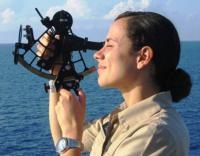 In 1998, the United States Naval Academy dropped celestial navigation from its curriculum. If a naval officer wished to know where he or she was, the officer simply had to read the display on a GPS (Global Positioning System) receiver. Sextants, chronometers, and nautical almanacs became artifacts of another, less technological time. Now, a decade and a the Navy has had second thoughts. Recent concerns about potential cyber-attacks on global positioning satellite software and data, which could disable or spoof GPS navigation systems world-wide, has led the Navy to return to teaching celestial navigation to midshipmen at the Naval Academy. Time to brush off the sextants.
In 1998, the United States Naval Academy dropped celestial navigation from its curriculum. If a naval officer wished to know where he or she was, the officer simply had to read the display on a GPS (Global Positioning System) receiver. Sextants, chronometers, and nautical almanacs became artifacts of another, less technological time. Now, a decade and a the Navy has had second thoughts. Recent concerns about potential cyber-attacks on global positioning satellite software and data, which could disable or spoof GPS navigation systems world-wide, has led the Navy to return to teaching celestial navigation to midshipmen at the Naval Academy. Time to brush off the sextants.
 When Ferdinand Magellan rounded the tip of South America in 1521, he encountered favourable winds. He named the ocean Mar Pacifico meaning “peaceful sea” in Portuguese. Today, Hurricane Patricia, the most powerful tropical cyclone ever measured in the Western Hemisphere, is expected to make landfall on the Mexican west coast near the resort cities of Puerto Vallarta and Manzanillo. This morning, the hurricane’s maximum sustained winds were measured an unprecedented 200 mph (320 kph). Weather.com reports that Hurricane Patricia now also holds the record for lowest pressure in any hurricane on record. With a minimum central pressure of 880 millibars (25.99 inches of mercury) at the 4 a.m. CDT advisory, Patricia broke the record of 882 millibars set by Wilma almost exactly 10 years ago. Perhaps, Magellan could have chosen a better name for the, so often, less than “peaceful” Pacific Ocean.
When Ferdinand Magellan rounded the tip of South America in 1521, he encountered favourable winds. He named the ocean Mar Pacifico meaning “peaceful sea” in Portuguese. Today, Hurricane Patricia, the most powerful tropical cyclone ever measured in the Western Hemisphere, is expected to make landfall on the Mexican west coast near the resort cities of Puerto Vallarta and Manzanillo. This morning, the hurricane’s maximum sustained winds were measured an unprecedented 200 mph (320 kph). Weather.com reports that Hurricane Patricia now also holds the record for lowest pressure in any hurricane on record. With a minimum central pressure of 880 millibars (25.99 inches of mercury) at the 4 a.m. CDT advisory, Patricia broke the record of 882 millibars set by Wilma almost exactly 10 years ago. Perhaps, Magellan could have chosen a better name for the, so often, less than “peaceful” Pacific Ocean.
The US Coast Guard rarely gets enough credit for the remarkable work that they do in routinely rescuing mariners in often extremely dangerous conditions. A new movie, “The Finest Hours“, is coming out this winter, which tells the story of what is considered by many to be the greatest small-boat rescue in Coast Guard history — the heroic effort to save the crew of the SS Pendleton in a horrible nor’easter off the coast of Massachusetts in 1952. Four men — coxswain Bernard C. Webber and his crew Andrew J. Fitzgerald, Richard P. Livese, and Ervin E. Mask — would later receive the Gold Lifesaving Medal, the service’s highest decoration for heroism during a rescue operation. The movie stars Chris Pine, Ben Foster and Eric Bana.
The real-life story behind Disney’s forthcoming Coast Guard rescue movie, ‘The Finest Hours’
The Finest Hours Official Trailer #1 (2015) – Chris Pine, Eric Bana Movie HD
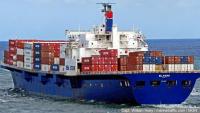 Yesterday afternoon, the National Transportation Safety Board (NTSB) released an updated report on their investigation into the sinking of El Faro in Hurricane Joaquin in early October. The report notes: “In a recorded satellite phone call to the company’s emergency call center at 7:00 am EDT, the captain told the call center operator that he had a marine emergency. He reported that there was a hull breach, a scuttle had blown open, and that there was water in hold number 3. He also said that the ship had lost its main propulsion unit and the engineers could not get it going.”
Yesterday afternoon, the National Transportation Safety Board (NTSB) released an updated report on their investigation into the sinking of El Faro in Hurricane Joaquin in early October. The report notes: “In a recorded satellite phone call to the company’s emergency call center at 7:00 am EDT, the captain told the call center operator that he had a marine emergency. He reported that there was a hull breach, a scuttle had blown open, and that there was water in hold number 3. He also said that the ship had lost its main propulsion unit and the engineers could not get it going.”
Continue reading
Happy Trafalgar Day! Today is the 210th anniversary of the overwhelming Royal Navy victory over the French and Spanish fleet off Cape Trafalgar on 21 October 1805. After considerable research, Admiral Nelson’s flagship HMS Victory has now been repainted to more accurately reflect the colors of the ship when she sailed into battle more than two centuries ago. Thanks to David Rye for contributing to this post.
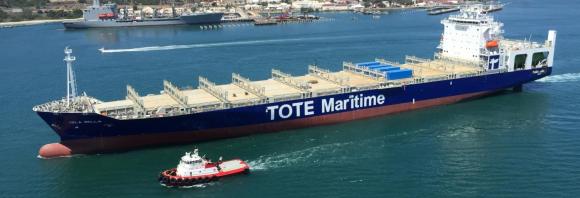
Photo : General Dynamics/NASSCO
NASSCO Shipyard in San Diego delivered Isla Bella, the world’s first LNG-powered container ship to TOTE Maritime. The 3100 TEU 764-foot long ship, the first of two 764-foot long Marlin Class container ships, should dramatically decrease emissions and increase fuel efficiency when compared to conventionally-powered ships, the equivalent of removing 15,700 automobiles from the road. The ship was delivered nearly two months ahead of schedule.
“Successfully building and delivering the world’s first LNG-powered container ship here in the United States for coastwise service demonstrates that commercial shipbuilders, and owners and operators, are leading the world in the introduction of cutting-edge, green technology in support of the Jones Act,” Kevin Graney, vice president and general manager of General Dynamics NASSCO, said in a press release. The Jones Act requires that all domestic shipping — shipping from one American port to another — be carried out by American-made and operated ships.
Isla Bella will be the newest Jones Act vessel in service. Tragically, TOTE Maritime’s El Faro, which was one of the oldest operating Jones Act ships, sank in Hurricane Joaquin, with the loss of 33 crew, on October 1.
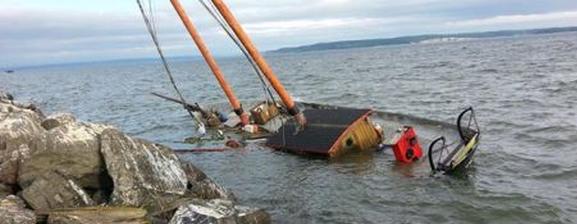 On October 9th, the schooner Phoenix dragged her anchor in a storm in Port Townsend harbor, Washington. She ended up sinking, holed on the rocks of the breakwater. The good news is that, after a week underwater, the schooner was been refloated and has been hauled out in Port Townsend. The Phoenix’s owner John Kruse is now figuring out how best to repair the schooner, including how he will finance it. He is using GiveForward.com to attempt to raise the funds to put the schooner back in service. To help out, click here.
On October 9th, the schooner Phoenix dragged her anchor in a storm in Port Townsend harbor, Washington. She ended up sinking, holed on the rocks of the breakwater. The good news is that, after a week underwater, the schooner was been refloated and has been hauled out in Port Townsend. The Phoenix’s owner John Kruse is now figuring out how best to repair the schooner, including how he will finance it. He is using GiveForward.com to attempt to raise the funds to put the schooner back in service. To help out, click here.
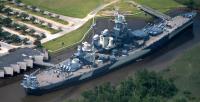
Photo: Doc Searls
The recent rain in the Carolinas has been close to unprecedented. Meteorologists have referred to it as the “1,000-year rainfall.” Another way to describe it is that it was “enough rain to float a battleship.” In this case, however, that was not a metaphor but literally what happened with the battleship USS North Carolina, which had been sitting firmly in the mud near shore on the Cape Fear River, in Wilmington, North Carolina. Flooding due to heavy rains added to the already high tides from the super blood moon eclipse resulting in an over 5-foot rise in the river, which proved enough to float the ship. The last time the battleship floated was in 2010. The river also flooded the parking lot causing the Battleship North Carolina Museum to close for several days.
Mark McCracken was out fishing for bonito half a mile off Gaviota State Beach, near Santa Barbara, when a hammerhead shark started bumping and circling his kayak. Mark, to his credit, didn’t panic, paddled toward shore and kept striking the shark with its paddle as it approached. The shark “followed me all the way into about three feet of water,” McCracken said. “Even after I got out of my kayak and made it to the beach he was sitting right there…it was pretty creepy.”
L. Francis Herreshoff was the son of naval architect, Nathanael Greene Herreshoff and the father of yacht designer and naval architect Halsey Herreshoff. L. Francis was widely respected as was a boat designer, naval architect, editor and author of books and magazine articles. Here, Doug Hylan speaks of L. Francis Herreshoff and QUIET TUNE, one of his designs.
Yacht designer Halsey Herreshoff at the Herreshoff Marine Museum in Bristol, Rhode Island, describing how his grandfather Nathanael Greene Herreshoff carved rather than drew the boats that he designed. The more interesting question may not be how Captain Nat carved the models but why. Read on after the page break.
How Herreshoff Designed His Boats
The most interesting question may be not how Nat Herreshoff designed his boats, but why carve them rather than draw lines plans? Continue reading
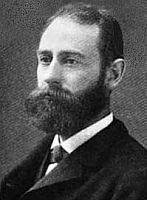 When Nathanael Green Herreshoff was around 16, he began to work for his elder brother, John Brown Herreshoff, in his boat yard in Bristol, RI. To work as an apprentice was a traditional way to learn the skills and techniques to become a successful yacht or ship designer and builder. Nathanael Herreshoff took a different course, however. At 19 her went to the Massachusetts Institute of technology and earned a degree in mechanical engineering. After graduation, he took a position with the Corliss Steam Engine Company in Providence, Rhode Island and worked for the firm for eight years. At the age of 30 in 1878, Nathanael returned to Bristol and became a partner with his elder brother in the Herreshoff Manufacturing Company.
When Nathanael Green Herreshoff was around 16, he began to work for his elder brother, John Brown Herreshoff, in his boat yard in Bristol, RI. To work as an apprentice was a traditional way to learn the skills and techniques to become a successful yacht or ship designer and builder. Nathanael Herreshoff took a different course, however. At 19 her went to the Massachusetts Institute of technology and earned a degree in mechanical engineering. After graduation, he took a position with the Corliss Steam Engine Company in Providence, Rhode Island and worked for the firm for eight years. At the age of 30 in 1878, Nathanael returned to Bristol and became a partner with his elder brother in the Herreshoff Manufacturing Company.
The unusual aspect of the partnership was that while his older brother, John Brown, known in the family as J.B., was highly successful boatbuilder, he was also blind. His blindness had not prevented him from being a skilled manager and a gifted businessman. The addition of the Nathanael as a partner added a skilled designer and engineer to the firm.
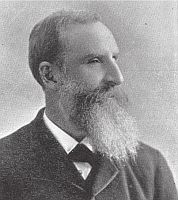 In 1859, 18 year old John Brown Herreshoff of Bristol Rhode Island, accepted his first commission to design and build a yacht. The fact that J.B., as he was known, was blind, having lost his sight at 15, didn’t seem to slow him down. He became known as the “blind boat builder.”
In 1859, 18 year old John Brown Herreshoff of Bristol Rhode Island, accepted his first commission to design and build a yacht. The fact that J.B., as he was known, was blind, having lost his sight at 15, didn’t seem to slow him down. He became known as the “blind boat builder.”
In 1863, J.B. took on space in an old tannery, hired a crew of shipwrights and established what would become the Herreshoff Manufacturing Company. In their first year, they built nine sailing craft, ranging from twenty-two to thirty-five feet long. The business continued to prosper and in 1868, the shop built its first steamer, followed by another in 1870, Seven Brothers, a pioneering fishing steamer. By 1874, J.B.’s yard had built upwards of 250 yachts and boats.
In 1878, J.B. formed a partnerships with his brother Nathanael Greene Herreshoff, seven years his junior. Together they improved the coil boiler designed by their oldest brother, James, and used the improved design in steam torpedo boats which they built for the U.S. Navy, as well as for the navies of Great Britain, Spain, Russia and Peru.
For the next five days, we will be posting about the amazing legacy of the Herreshoff family on American yacht design and construction. Today we begin with the restoration of the yacht Doris, the first yacht built to the Universal Rule, developed by Nathanael Herreshoff. Then we will review the careers of John Brown Herreshoff, the blind boatbuilder, and Nathanael Greene Herreshoff, known as the Wizard of Bristol. Next naval architect and yacht designer, Halsey Herreshoff, will explain how his grandfather, Captain Nat, carved models of his designs. We will follow by a look at Quiet Tune, a design by L. Francis Herreshoff, the son of Nathanael and the father of Halsey Herreshoff.
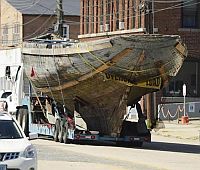
Photo: The Day/Sean D. Elliot
Drivers on Interstate 95 in Connecticut may have been surprised recently to see the 78-foot, wooden yacht Doris traveling by trailer down the highway, on her way to restoration and a new life. The 1905 built sloop is believed to be the largest surviving wooden yacht from the famous Herreshoff Manufacturing Company of Bristol, Rhode Island. Doris has been stored at Crocker’s Boat Yard in New London for the past 30 years or so, was moved to the Taylor & Snediker Yacht Restoration company of Pawcatuck. The yacht was scheduled to be scrapped at the end of August 2013, but a new, currently anonymous, owner was found. New England Boating reports that “Taylor & Snediker may employ up to 9 workers to work full time for the next 5 years on Doris. When the work is completed, most of the original frames, planking and other components will have been replaced.”
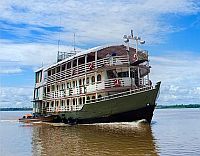 I will be out of the range of the internet for a few days, so I apologize if I am slower than usual responding to comments and emails. I will be in the Amazon Basin of Peru on the river boat, M/V La Amatista and will report back on my return.
I will be out of the range of the internet for a few days, so I apologize if I am slower than usual responding to comments and emails. I will be in the Amazon Basin of Peru on the river boat, M/V La Amatista and will report back on my return.
I happened to come across an absolutely magnificent video by Pierre Henkart. Beautiful video and editing of the Pride under sail as well as great shots of sail handling by the crew. Definitely worth the 5 minutes and 40 seconds to watch. Or even, 11 minutes 20 seconds to watch twice.
Hayley and Rob entertain belugas with a cello concert in Churchill Sound, Manitoba, Canada.
More video, after the page break.
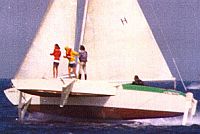
Williwaw
This summer, the French 60′ foiling trimaran Hydroptere sailed 2215 nautical miles from Los Angeles to Hawaii. The winds were not favorable and the passage was not terribly fast at about 11 days, compared to the four day record set by the 110-foot trimaran Geronimo in November 2005. Nevertheless, as most hydro-foiling sailboats are limited to relatively calm water, the ocean passage was itself an achievement. Hydroptere was not however, despite all claims, the “the first flying hydrofoil to cross an ocean.” In fact, she was not the first by almost a half century.
In the late 1960s and early 70s, an engineer named Dave Keiper designed and built the world’s first hydrofoil sailing yacht, a 32-footer named Williwaw. Keiper cruised 20,000 miles around the Pacific sailing twice to Hawaii from the West Coast and back and then on to the South Pacific as far as New Zealand in 1976. Keiper died of heart failure on June 27, 1998 at the age of 67. Keiper’s book Hydrofoil Voyager: WILLIWAW, From Dream To Reality and Toward the Sailing Yacht of the Future has recently been republished. A video of Willawaw underway:
